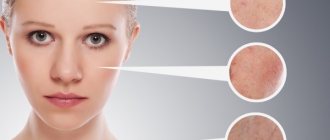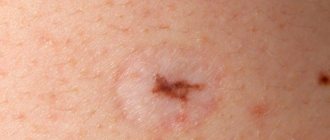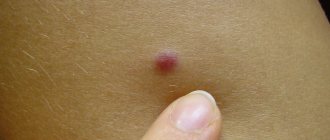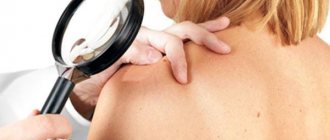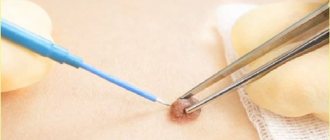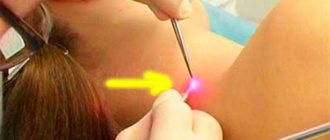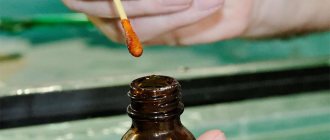Moles (nevi) are quite common on the human body. They can be congenital or acquired. They differ in size, structure, color, etc. Most often they do not pose a danger, but under certain conditions they can transform and become malignant under the influence of excessive sun rays, constant injury from clothing, etc. In this case, it is important to remove them in time. But the desire to get rid of a mole can also be caused by the cosmetic defect that it forms.
Regardless of the reason for the removal, it is better to have it done by a doctor, but not in a beauty salon. The mole must be examined by a specialist (oncodermatologist) and give his opinion. In addition, only a doctor can determine the choice of optimal treatment and the advisability of removal. Carrying out histology is also possible only in a clinical setting.
Mole. Why is a mole dangerous?
Moles or nevi are benign skin formations that are formed as a result of impaired synthesis and metabolism of melanin.
Moles may be flat, protrude slightly above the skin, or may be smooth or covered with hair. Most often, moles do not cause problems and are more of a cosmetic flaw. But the insidiousness of these formations is that they can degenerate into malignant ones, causing a serious disease - melanoma or skin cancer. Various factors can provoke degeneration: excessive tanning, both in the sun and in a solarium, injuries, damage to moles, massage, hormonal treatment. A reason for concern should be a sharp increase in the number of moles, their rapid growth, changes in color and shape, pain and bleeding, peeling, hair loss from the mole, the appearance of compaction, blurring of the edges, and the appearance of a red rim around the mole. You should be especially attentive to moles that are subject to constant mechanical irritation and can be easily injured. These are moles located on the head, in the armpits, and in intimate places. In any case, each mole removal procedure must be preceded by a consultation and opinion of a doctor - a dermatologist or oncologist, who will determine the type of mole and select the best option for its removal, determine the depth of its occurrence and the required depth of the procedure.
How to get rid of moles
If moles begin to bother you and cause discomfort, then the moles need to be removed as quickly as possible. The most important thing you shouldn’t do is try to get rid of a mole, and especially a troublesome mole, on your own in “makeshift” conditions. Independent “operations” are strictly prohibited, as they can cause complications: blood poisoning or large blood loss, because there is a chance that you simply will not be able to stop the flow of blood if you disturb or damage the mole.
It is also not recommended to carry out the procedure for removing moles in beauty parlors and beauty salons, unless they have certified and qualified dermatologists and oncologists. There are several methods for removing moles (surgical, electrocoagulation, cryodestruction, laser evaporation), and only an experienced doctor can advise the most appropriate solution to the problem in each specific case. The choice of mole removal method is usually based on the characteristics and condition of a particular mole, as well as the degree of possible threat to the body.
Methods for removing moles (nevus)
Previously, the main methods for removing moles were cryodestruction using liquid nitrogen and the electrocoagulation method. During cryodestruction, the formation is frozen out with low-temperature liquid nitrogen. The electrocoagulation method is based on local exposure to high frequency current. However, the use of these techniques to remove moles may have a side effect such as secondary thermal tissue damage with the formation of blisters. In addition, the spread of both cold and heat in the skin and tissues is not controlled, so healthy areas can also suffer.
To remove large moles, a surgical excision method is used, after which intradermal cosmetic sutures are applied. However, this technique is not entirely suitable for removing moles located on the face. The method of surgical excision is old and was used earlier, when the development of technology did not allow mole removal procedures to be carried out at such a high level as now. However, it still has a place in medical practice and some still prefer it in the old fashioned way. Doctors also recommend this method in cases where the mole has reached very large sizes, both in width and depth. After the operation, cosmetic stitches are applied, which are removed after about a week. The result of this procedure from a cosmetological point of view is a scar 2-3 mm thick.
For such a precise procedure, as for removing moles in areas with thin skin (eyelids) and mucous membranes (perineal area), the radio wave coagulation method is more suitable. This is the safest method because it does not cause thermal damage to the skin and does not leave scars. Radio wave coagulation is especially effective for eliminating protruding moles that have a clear contour on the skin. The working part of the device is a tungsten filament, with the help of which the tumor is removed in one movement. The duration of the procedure is only five minutes. There is no bleeding or swelling, which allows the patient to go home immediately after surgery.
Whatever method you choose to remove moles, you need to strictly follow the doctor’s instructions and not act on your own. Proper care of the newly formed skin in the place where the mole used to be will allow you to achieve maximum effectiveness of any method and avoid unwanted residual manifestations.
Wart after cauterization with nitrogen: care and consequences
A wart on the skin is a formation that causes discomfort. Firstly, it is ugly, and a person begins to feel ashamed. Secondly, warts often cause painful sensations: they are painful to touch, and unpleasant sensations may also occur inside the localization of the formation. The appearance of papilloma is a possible signal that a person’s immunity is weakened and it is worth taking measures to increase the body’s defenses. Of course, it is much easier to feel when the wart disappears after cauterization with nitrogen, because then the aesthetic appearance is much better, and it can be disguised.
If you do not take any measures to get rid of tumors, then they can subsequently spread throughout the body and even appear on the scalp, soles, armpits, buttocks, and genitals. The natural desire of every person who has them is to remove or cauterize the ugly growth as quickly as possible.
How is cryodestruction of warts performed?
One of the quick methods for eliminating skin formations is cryodestruction - deep freezing or removing warts with liquid nitrogen. In the process of cauterization with liquid nitrogen and exposure to low temperatures (up to -196 degrees Celsius). As a result, the cells of the skin growth die, the papilloma dies, and the skin, after removing the wart, takes on its usual healthy appearance. Anesthesia is usually not required, and the procedure itself lasts no more than half a minute, which, of course, is a huge advantage among other methods for excision of moles.
The procedure is carried out manually by a dermatologist, with occasional anesthesia (if the removal of papillomas occurs in a small child or the size of the neoplasm itself is very large).
Thus, from a special reservoir in which liquid nitrogen is located, the required amount of this substance called “nitrogen” is drawn through an elongated applicator. Then, a cotton applicator is pressed against the growth and held on the affected area for up to 30 seconds. The larger the size of the papilloma, the longer the nitrogen applicator is held.
The burning time also depends on the location of the tumor: the plantar ones take the longest to remove, since the skin on the feet is quite rough. Additionally, we note that specialists with special medical education in ordinary cosmetology offices have the right to carry out the process, so going to a specialized clinic is not necessary.
What happens to a wart when it is exposed to liquid nitrogen?
What does papilloma look like after exposure to liquid nitrogen?
After the applicator with this freezing substance touches the skin growth, it begins to turn white, and its structure becomes denser. The wart may turn red after cauterization with nitrogen. Some time later, after completing the procedure under the unusual name “cryodestruction,” a blister containing serous fluid may form on the surface of the epithelium treated with nitrogen. The vesicle with transudate usually resolves within 7-10 days. The procedure does not leave any consequences on the surface of the epithelium, and there are no scars or marks left on it.
Is nitrogen cauterization painful?
The method of cauterizing a wart with liquid nitrogen is considered one of the most non-traumatic ways to eliminate skin lesions. Its cost, and the short recovery period after exposure to a freezing substance on the epidermis, make cryodestruction one of the popular methods of therapy.
As for the unpleasant, burning and prickly sensations, it all depends on the individual pain threshold of the person. In terms of sensitivity, the effect of liquid nitrogen on the epithelium causes a slight tingling sensation - similar to when you touch one of the metal objects in severe frost and hold your palm on it for a while.
Reviews from people who have been exposed to skin growths with a freezing substance also contain similar impressions of the procedure. As a rule, moles are small in size, and therefore no unpleasant feelings arise from cryodestruction. Even when a bubble appears after removing a wart with liquid nitrogen, it usually does not cause pain.
Contraindications for cryodestruction
In order to cauterize the growth, you need to make sure that there are no contraindications for the procedure.
Exposure to warts with nitrogen is not carried out if:
- presence of high blood pressure;
- hyperemia and rashes near the affected area;
- elevated body temperature in a patient due to acute respiratory infections, flu, colds;
- infections;
- chronic inflammatory processes in the body;
- epilepsy;
- existing individual intolerance to the action of the ingredient on the skin (cold allergies).
Complications and consequences that arise or appear spontaneously after removing a wart with liquid nitrogen may still occur.
Possible complications and consequences after the procedure
Usually, after exposure to a wart, a bubble forms at the site where the skin was exposed to liquid nitrogen. It has a transudate inside and requires care - this factor should be taken into account. Until the blister resolves, the epithelium needs to be looked after: it must be treated with salicylic alcohol or use a weak solution of potassium permanganate. Under no circumstances should the bladder be punctured, otherwise complications may arise in the form of:
- inflammation in the epidermal area;
- increasing the regeneration period of the affected skin area;
- the appearance of a scar on the surface of the dermis.
We will consider further what needs to be done after cauterizing a wart with liquid nitrogen, because this is a very important question that interests many. The main thing is not to apply cosmetic tanning creams, dermis, or in general those that contain a chemical composition.
What to do after cauterization with liquid nitrogen?
After burning with nitrogen has ended and a blister has appeared after exposure of the skin to nitrogen, it is necessary to provide post-procedure care for the area of the dermis where the wart was located.
What not to do:
- touch the bubble;
- puncture a blister;
- cut off the wart;
- wet the formation and the crust that appears on it;
- use cosmetics (if the papilloma was on the face);
- appear in the sun (if you do not want your dermis to turn black, especially if it is dark-skinned and has brought a number of other ailments).
A blister that appears on the epidermis is smeared with salicylic alcohol twice a day; eventually, a crust will appear on it, it will dry out, and there will be no marks or scars left on the surface. A new layer of healthy epithelium forms in place of the former wart. Typically, the complete healing process takes about 10 days. It is necessary to monitor the condition of the affected area daily, and if there is the slightest deterioration (if the blister begins to turn black or fester), you should consult a doctor.
To reduce the consequences of the procedure, and also to prevent the recurrence of warts, the patient must follow a number of measures.
Prevention - what is important to know?
What you can do:
- observe the rules of personal hygiene;
- use separate utensils;
- wash linen and bedding regularly;
- regular sanitization of the room where the patient is located and disinfection of common areas (bathroom, bathtub, toilet);
- change of washcloths, sponges for washing.
It is especially important to follow these recommendations after burning off the spines, since burning the warts with liquid nitrogen can cause a burn to the foot. If the patient cannot move after removal of the papilloma, it is important that the person caring for him thoroughly disinfects his hands after contact with the patient.
Whatever method you choose to remove growths, it is important that the treatment is carried out by a qualified specialist in a certified clinic or at least in a cosmetology office that has all the certificates and permits to carry out a procedure called “cryodestruction”. Only in this case can excision occur without any consequences for the patient!
Self-removal of papillomas and self-medication leads to negative effects on the body; it is better not to use dubious methods of treatment. Remember that even if you decide to take desperate measures - taking medications, it is better to start with regular vitamin complexes, and it is better to first consult with your doctor so that all this is taken in conjunction with a special diet, an active lifestyle, and so on. It is also important to adjust your drinking regime and drink at least two liters a day of still, or preferably filtered, water.
It is very important to boost the immune system, because if it is strong, then no tumors will be able to progress on the surface of the epithelium, and you will be able to feel protected from such a dangerous disease as HPV.
Removing moles with laser (laser mole removal)
Removing moles using laser is also considered a modern and safe method. During the procedure, the laser removes the mole layer by layer. Anesthesia is used at the request of the patient. A small depression remains at the removal site, which gradually levels out within two weeks after the procedure. The big advantage of the technique is the ability of the laser to thrombose the smallest vessels when removing a mole. This eliminates blood loss and, most importantly, eliminates the possible occurrence of metastases. Removing moles with a laser leaves virtually no marks on the patient’s body, and this is important when working on open areas of the body, especially the face. But of course, it is worth considering that the final result depends both on the type of laser installation and on the skill of the doctor, who must take into account the depth of the mole and calculate the force of impact.
Scars
A scar after mole removal is quite normal. You should not expect that the removal procedure will take place without any consequences. In most cases, such a scar will not be able to go away on its own, just like just a small scar after removal of a mole.
So, how can you deal with this problem? For example, you can try lubricating these places with cocoa butter - now you can buy it in one of the pharmacies.
A colloidal scar after mole removal can also be removed using a silicone patch, which must be worn for two or three weeks. However, such a patch should also be prescribed exclusively by a specialist.
But if, after removing a mole, a tubercle appears that does not resolve, you may have to use the services of plastic surgery. In this case, the patient does not have to worry about being left with a rough, pronounced scar. The scars are smoothed out so that they are practically invisible.
If a mole was removed not because it spoiled a person’s appearance, but because it was constantly injured, you must remember to regularly examine your body. Particular attention should be paid to remaining moles and their changes in appearance.
Laser mole removal procedure
The laser removal procedure looks like this: local anesthesia is applied to the treatment area, and then, using modern lasers, the surface of the mole is gradually processed, evaporating its layers one by one. The high accuracy of such operations is ensured by the latest laser technologies - you can control the depth of exposure and set the required beam diameter. Why is this method so popular among doctors? Its first and main advantage is the complete absence of any even the slightest bleeding, the complete elimination of the possibility of contamination of the treated surface with various microbes and infections, since laser treatment is a non-contact procedure. Well, important factors are the aesthetic side and the time spent on the removal process itself, as well as the recovery period of the treated area of skin.
The laser “operation” itself lasts less than 5 minutes, and the recovery period of the skin in the treatment area does not exceed 2 weeks. Moreover, after complete healing and regeneration of the skin, practically no traces remain at the site of the former mole.
Today, laser is considered the only way to remove moles without a trace. Also, using a laser, highly effective treatment of benign formations, such as moles, warts, and papillomas, is performed.
The consequences of mole removal are extraneous symptoms that occur during the postoperative period and pose a danger to the patient’s health. Consulting a doctor will help you decide how to remove a wart without serious complications. Moles on the body are often not problematic, some cause discomfort and cause the development of various ailments. To eliminate the problem, some people prefer to remove moles.
Restrictions during the recovery period
There is a whole list of requirements that must be observed during the recovery period after the procedure for removing a mole (nevus). At this time you cannot:
- use any medications not agreed with or recommended by your doctor;
- apply decorative cosmetics and lotions to the treated area (especially for removal on the face and neck);
- wet the mole excision area for 4-5 days;
- steam the treated area (expose it to moist heat - that is, it is forbidden to visit the sauna and steam room);
- injure, comb the skin and remove the crust;
- drink alcohol in any form and any strength (up to a week);
- sunbathe or sunbathe in a solarium (up to 4 weeks).
All this will avoid hyperpigmentation and unwanted side effects. It will also prevent the risk of secondary infection and help the wound heal faster without leaving scars.
Can there be dangerous consequences after removal?
Nevi are removed for several reasons: aesthetic discomfort, the appearance of suspicious symptoms (itching, burning, redness), location in dangerous areas of the body. Formations on the head are injured when combing hair; nevi can be injured by clothing, shoes, or a razor during shaving.
The main consequences that a person faces after a procedure of this nature are identified:
- Relapse is the re-growth of a mole at the site of removal. In this case, a dermatologist or oncologist takes a biopsy test. It is necessary to know the nature of education.
- Infection. Improper wound care during the rehabilitation period causes infection in the wound. It begins to fester and become inflamed. Doctor's help required.
- The appearance of scars is possible after some types of operations. Scarring occurs when the wound is not properly cared for.
- Metastasis. Excision of a malignant tumor is always dangerous due to relapse and the growth of metastases.
Causes of complications after the procedure
The speed of skin recovery after the procedure and the likelihood of negative consequences are influenced by the method of destruction of the birthmark and the thoroughness of care during the rehabilitation period.
- Layer-by-layer removal of moles with a laser is considered effective and low-traumatic. The risks of complications are minimal. A small scar and pigmentation of skin cells may be observed at the site of the removed formation.
- Freezing with liquid nitrogen does not guarantee complete destruction of the seal. It is impossible to regulate the depth of nitrogen penetration under the skin. The effect may be temporary. There is a threat of relapse.
- The knot of pigmented cells is removed using an electrocoagulator. The surgitron coagulator is widely used in gynecology to remove moles on the cervix.
- Excision with a radio knife is a safe, effective method.
- A scalpel is used to remove malignant tumors that can develop into cancer.
Removal methods
| Removal methods | Advantages | Flaws |
| Surgical | the only treatment for incipient melanoma | the operation may take a long time; there will be a scar on the body |
| Cryodestruction | the ability to remove large moles; affordability; no scars after the procedure | repeated removal is required; Mole removal on the face is not carried out |
| Radio wave | does not leave scars; it is possible to conduct histology to determine the malignancy of the formation | it is possible to get rid of small red moles |
| Laser | painless and quick procedure; no scars | inability to conduct histology; expensive method |
| Electrocoagulation | removes the tumor in one go; does not form wounds on the surface of the skin | You can only get rid of small moles |
What to do if the inflammatory process begins
The main condition for ensuring a successful and rapid process of healing and restoration of the skin after destruction of the formation is proper care and adherence to hygiene rules.
Burning with celandine can injure the skin and not remove the nevus. Only a specialist can guarantee the quality of the procedure.
A crust appears on the wound for several days, then disappears. Normally, inflammation is observed within 2-5 days after the procedure; slight pain at the removal site is not a cause for concern. If pus appears or your health worsens, you should consult a doctor.
Temperature
An increase in body temperature after removal of a mole is observed in individual cases. Depends on the body’s defenses and reactions to the stressful situation that has occurred.
Swelling of the skin at the surgical site may persist for a long time. Hyperthermia is accompanied by increased sweating, and the person feels chills.
Prolonged persistence of symptoms is evidence of the development of the inflammatory process. It is provoked by the introduction of pathogenic microorganisms into the wound. What may happen:
- during a procedure performed under inappropriate, non-sterile conditions;
- if the wound care rules are not followed during the rehabilitation period.
Solution of potassium permanganate and “Fukortsin”
Antiseptic solutions are intended to prevent suppuration of the place where the mole was removed. What to process? More often than others, potassium permanganate and Fukortsin are used. Potassium permanganate or potassium permanganate is a strong oxidizing agent and even when diluted retains its properties. The potassium permanganate solution should be 0.1-0.5%. This means consumption of 6-8 of its crystals per liter of water. It should be poured into a glass container and be warm. If it is impossible to count, make the solution “by eye” - after mixing it should have the color of red wine.
After preparation, you need to dip a cotton swab into the solution and gently wipe the surface of the former mole. The surrounding skin should also be wiped.
“Fukortsin” is a ready-made pharmaceutical solution of dark red color. Has antimicrobial and fungicidal effects. It can also be applied, but it should not be allowed to come into contact with mucous membranes. Treatment frequency is 1-3 times a day.
How else to treat the mole removal site? It is possible to use solutions of “Chlorhexidine”, “Furacilin”, brilliant green, iodine, chamomile infusion, hydrogen peroxide.
After about a week, the existing crust, in the absence of complications, falls off on its own, and fresh new skin remains in its place. It can easily be injured, so you need to protect it from damage and ultraviolet radiation. Over time, its color evens out. It should be protected regardless of the time of year - before going outside, lubricate your skin with sunscreen. Additional skin treatment after removal of a mole is needed in case of infection in the form of weeping, pus, itching, redness, etc.
Can improper removal cause death?
In extremely rare cases, complications after mole removal can cause death. Concerns incomplete excision of a malignant nevus. If the remaining particles enter the lymphatic system, the bloodstream, they spread throughout the body rapidly. The consequence will be the formation of metastases in the body. Death is possible if treatment is refused.
There is an increased risk of developing melanoma in those who remove nevi on their own at home, using improvised means and folk recipes. If you contact a specialist in a timely manner and carry out proper removal of the mole, the patient will avoid serious complications and will not die.
Numerous moles on the body need observation. You should not look for alternative medicine to remove nevus. It is important to contact a specialist in time. Correctly carried out mole removal, following the doctor’s recommendations, regular examinations are a guarantee of health for many years without annoying consequences or complications.
Mole removal is a simple and common procedure. Modern cosmetology and medicine make it possible to get rid of almost any unwanted and dangerous neoplasms on the face, body and mucous membranes. However, despite the large selection of removal methods, the procedure remains “conditionally surgical,” that is, it is carried out with a violation of the integrity of the tissue. Therefore, it is important to ensure proper wound care after such an intervention to avoid complications. We'll talk about possible complications below.
When should you delete?
In most cases, nevus is a benign skin tumor that does not require additional outside intervention. Under unfavorable conditions, injury, hormonal imbalances in the body or after serious illnesses, moles can degenerate into malignant tumors. The first signs of such degeneration are:
- rapid growth of tumors;
- pain, itching, peeling;
- bleeding;
- changes in color and shape.
If these symptoms appear, consult a doctor - a dermatologist or oncologist.
Another indication for removal is that the nevus is not aesthetically pleasing. If the mole is large and located on an open area of the body, then most likely it causes some discomfort.
How to get rid of nevi?
The most modern and popular method is laser coagulation of moles. The latest technologies make it possible to get rid of tumors of any size and from any part of the body. The laser, penetrating the epidermis, affects the nevus without damaging the surrounding tissue. The procedure takes a few minutes and is comfortable and painless for the patient.
After the procedure, the wound heals quite quickly, about 5-6 days. Since skin damage is minimal, long-term recovery is not required. The laser leaves a dark crust at the site of the nevus; after a week it disappears without a trace.
Why moles turn black and what to do about it
If a mole changes
Moles are a consequence of the excessive work of melanocytes that produce the pigment melanin, resulting in the formation of its clusters. The more pigment in nevus cells, the darker the neoplasm; black moles have the largest amount of melanin. They can form at any age, and in themselves are not dangerous; only those nevi that were light at first and then began to turn black should be alarmed.
Many nevi are completely safe for human health and life, but some of them can degenerate into a malignant melanoma tumor, this process is called malignancy. A change in the color of the tumor is one of the symptoms indicating this pathological process. First, black dots may appear on the surface of the mole, then they will grow, forming spots, and then they may even go beyond the boundaries of the nevus.
In some cases, a mole darkens only due to development; there are no negative reasons for this. But in this case, changes occur slowly and gradually, rather than abruptly.
Causes of darkening
A neoplasm can turn black for several reasons, and not all of them are dangerous. Knowing the prerequisites for changes will help prevent a similar situation in the future and select the right effective measures. A change in the shade of a mole can be caused not only by its transformation into melanoma, but also by factors that affect the functioning of melanocytes and the amount of melanin they produce.
The most common provocateur for the appearance of new moles and changes in old ones is aggressive ultraviolet radiation - natural (sun) and artificial (solarium). Excessive addiction to tanning can also have a negative side, since active ultraviolet rays can provoke various skin diseases, including the formation of moles and their degeneration into melanoma. For this reason, if you have had cases of darkening of the nevus, then it is advisable to be careful about tanning; experts do not recommend sunbathing from 11 am to 4 pm.
Another reason that a mole has turned black may be hormonal changes in the body. This most often occurs during puberty, during pregnancy and with the onset of menopause in women, but some diseases can also provoke an imbalance. Hormones can negatively affect all internal systems and organs of a person, and external changes only increase the need to see a doctor.
Signs of malignancy
If you notice that one of your tumors has begun to change color, this is already a reason to contact a dermatologist or oncologist. Even if it seems to you that there is nothing dangerous in the changes, you should still visit the hospital. If your assumption is correct, the doctor will only confirm this and you will be calmer; otherwise, he will prescribe appropriate treatment and, if necessary, removal of the nevus. In addition to darkening of the tumor, the following changes may indicate malignancy:
- the mole began to sharply increase in size, its shape and outline changed;
- blood or other fluid often bleeds from the neoplasm;
- hair began to grow from the nevus, which was not there before;
- a white halo of discolored skin appeared;
- red dots appeared;
- the surface has become rough and covered with cracks;
- the growth begins to hurt, itch or become inflamed;
- seals appeared on the mole and the skin around it.
The presence of at least one of these symptoms should already alert you, and the combination with darkening of the mole practically obliges you to consult a specialist. Melanoma noticed in the early stages is treatable in the vast majority of cases, but for advanced pathology the prognosis is not so positive.
If the hanging nevus turns black
On the human body, in addition to the usual flat or slightly convex birthmarks, there may be hanging moles, which look like small papillae attached to the epithelium with a thin short stalk. A hanging mole is flesh-colored, small in size, has a rough surface, and is located in the neck, armpits, or intimate area. This melanoma neoplasm is not dangerous, but it is very easy to damage it with clothing, jewelry or personal hygiene products.
If a hanging mole has darkened, the reasons may be the same as in the case of other varieties, but a change in shade may occur due to mechanical damage. If such a nevus tears or comes off completely after darkening, you need to contact a specialist as soon as possible, as this is fraught with unpleasant consequences. A hanging mole is localized not only on the surface of the skin, its base can be located in deep layers, and if the neoplasm is damaged, nevus cells begin to grow throughout the body. In this case, when going to the hospital, removal of the base of the nevus remaining in the skin is prescribed.
Ways to remove a darkened mole
Only a qualified surgeon who has a special license to carry out such activities can remove a blackened tumor. A suitable technique is selected only after passing the necessary tests and studying the nature of the nevus. In addition to a visual examination, non-invasive tests may be prescribed - dermatoscopy and siascopy, and in particularly difficult cases a biopsy is performed.
If a specialist sees that a mole has turned black due to its degeneration into melanoma, he will recommend a traditional operation. It is performed under local anesthesia; after removal of the tumor, it is sent for histological analysis. The rehabilitation period after surgery is quite long, in addition, there is a high probability of scar formation, but this is the most reliable way to get rid of a malignant tumor.
If the nevus does not pose a threat to human health and life, a specialist may suggest hardware removal methods. They are characterized by the absence of bleeding during exposure, a short rehabilitation period and the absence of scars in most cases. Such techniques include laser therapy, cryodestruction (removal of growth with liquid nitrogen), electrocoagulation (exposure to electric current) and radioknife (use of high-frequency electromagnetic waves).
Undesirable actions
If you notice that a mole has turned black, it is better not to self-medicate and go to the hospital as soon as possible. A self-made diagnosis may be incorrect, but the doctor will always tell you what needs to be done to get rid of the consequences of a change in the shade of the nevus and prevent such a situation in the future.
Traditional medicine is still widely used, promising quick positive changes without pain and large financial costs. However, in the case of a changed mole, it is not recommended to use such methods, since they can only worsen the situation. Any mechanical and chemical damage to the nevus without its complete removal will most likely lead to an accelerated process of malignancy.
Also, some recommend covering a blackened mole with a band-aid before visiting the beach or solarium so that it does not change further. It is difficult to say about the effectiveness of this method, but you should not do this, since in this case a greenhouse effect will be created. It can do a bad job, and even without the influence of direct ultraviolet rays, the nevus can begin to transform.


